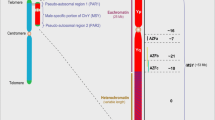Abstract
Mammals produce sperm or oocytes depending on their sex; however, newborn MRL/MpJ (MRL) male mice produce oocytes within their testes. We previously reported that one of the genes responsible for this phenotype is present on the MRL-type Y chromosome (YMRL), and that multiple genes, probably autosomal, are also required for the development of this phenotype. In this study we focused on the autosomal genes and examined their relationship with this phenotype by analyzing the progeny from crosses between MRL mice and other strains. We first observed the male F1 progeny from the crosses between female A/J, C57BL/6 (B6), BALB/c, C3H/He, or DBA/2 mice and male MRL mice, and two consomic strains, male B6-YMRL and MRL-YB6. Testicular oocytes that were morphologically similar to those of MRL mice were detected in all mouse strains except BALBMRLF1; however, the incidence of testicular oocytes was significantly lower than that in MRL mice. The appearance of testicular oocytes in MRL-YB6 mice indicates that this phenotype is strongly affected by genomic factors present on autosomes, and that there is at least one other causative gene on the MRL-type autosomes (MRL testicular oocyte production, mtop) other than that on YMRL. Furthermore, a quantitative trait locus (QTL) analysis using N2 backcross progeny from crosses between female MRLB6F1 and male MRL mice revealed the presence of susceptibility loci for the appearance of testicular oocytes at 8–17 cM on Chr 15. These findings demonstrate that the appearance of testicular oocytes is regulated by the genetic factors on Chr 15 and on YMRL.





Similar content being viewed by others
References
Albrecht KH, Yound M, Washburn LL, Eicher EM (2003) Sry expression level and protein isoform differences play a role in abnormal testis development in C57BL/6J mice carrying certain Sry alleles. Genetics 164:277–288
Barrionuevo F, Bagheri-Fam S, Klattig J, Kist R, Taketo MM, Englert C, Scherer G (2006) Homozygous inactivation of Sox9 causes complete XY sex reversal in mice. Biol Reprod 74:195–201
Berta P, Hawkins JR, Sinclair AH, Taylor A, Griffiths BL, Goodfellow PN, Fellous M (1990) Genetic evidence equating SRY and the testis-determining factor. Nature 348:448–450
Bullejous M, Koopman P (2005) Delayed Sry and Sox9 expression in developing mouse gonads underlies B6-Y DOM sex reversal. Dev Biol 278:473–481
Choi Y, Qin Y, Berger MF, Ballow DJ, Bulyk ML, Rajkovic A (2007) Microarray analyses of newborn mouse ovaries lacking Nobox. Biol Reprod 77:312–319
Eicher EM, Washburn LL (1986) Genetic control of primary sex determination in mice. Annu Rev Genet 20:327–360
Eicher EM, Washburn LL, Whitney JB III, Morrow KE (1982) Mus poschiavinus Y chromosome in the C57BL/6J murine genome causes sex reversal. Science 217:535–537
Eicher EM, Washburn LL, Schork NJ, Lee BK, Shown EP, Xu X, Dredge RD, Pringle MJ, Page DC (1996) Sex-determining genes on mouse autosomes identified by linkage analysis of C57BL/6J-YPOS sex reversal. Nat Genet 14:206–209
Kocer A, Pinheiro I, Pannetier M, Renault L, Parma P, Radi O, Kim KA, Camerino G, Pailhoux E (2008) R-spondin1 and FOXL2 act into two distinct cellular types during goat ovarian differentiation. BMC Dev Biol 8:36
Koopman P, Gubbay J, Vivian N, Goodfellow P, Lovell-Badge R (1991) Male development of chromosomally female mice transgenic for Sry. Nature 351:117–121
Manly KF, Cudmore RH Jr, Meer JM (2001) Map Manager QTX, cross-platform software for genetic mapping. Mamm Genome 12:930–932
McElreavey K, Barbaux S, Ion A, Fellous M (1995) The genetic basis of murine and human sex determination: a review. Heredity 75:599–611
McLaren A (1984) Meiosis and differentiation of mouse germ cells. Symp Soc Exp Biol 38:7–23
McLaren A (1995) Germ cells and germ cell sex. Philos Trans R Soc Lond B Biol Sci 350:229–233
Murphy ED (1981) Lymphoproliferation (lpr) and other single-locus models for murine lupus. In: Gershwin ME, Merchant B (eds) Immunologic defects in laboratory animals. Plenum Press, New York, pp 143–173
Otsuka S, Konno A, Sasaki N, Endoh D, Hashimoto Y, Kon Y (2008a) Oocytes in newborn MRL mouse testes. Biol Reprod 79:9–16
Otsuka S, Konno A, Sasaki N, Endoh D, Hashimoto Y, Kon Y (2008b) Polymorphism in MRL and AKR mice Sry: a candidate gene for the appearance of testicular oocyte. Jpn J Vet Res 56:129–138
Prager EM, Boursot P, Sage RD (1997) New assays for Y chromosome and p53 pseudogene clines among East Holstein house mice. Mamm Genome 8:279–281
Sim H, Argentaro A, Harley VR (2008) Boys, girls and shuttling of SRY and SOX9. Trends Endocrinol Metab 19:213–222
Tevosian SG, Albrecht KH, Crispino JD, Fujiwara Y, Eicher EM, Orkin SH (2002) Gonadal differentiation, sex determination and normal Sry expression in mice require direct interaction between transcription partners GATA4 and FOG2. Development 129:4627–4634
Acknowledgments
This study was supported by grants from Research Fellowships of the Japan Society for the Promotion of Science for Young Scientists (No. 20001195), the Ministry of Education, Culture, Sports, Science and technology, Japan (Nos. 19380162, 22780257, 24380156, and 24780278), the Kurata Memorial Hitachi Science and Technology Foundation, Takeda Science Foundation, and Hayashi Memorial Foundation for Female Natural Scientists.
Author information
Authors and Affiliations
Corresponding author
Rights and permissions
About this article
Cite this article
Otsuka, S., Ichii, O., Namiki, Y. et al. Genomic analysis of the appearance of testicular oocytes in MRL/MpJ mice. Mamm Genome 23, 741–748 (2012). https://doi.org/10.1007/s00335-012-9405-3
Received:
Accepted:
Published:
Issue Date:
DOI: https://doi.org/10.1007/s00335-012-9405-3




